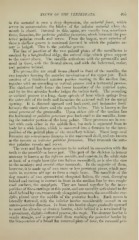Page 395 - My FlipBook
P. 395
TEETH OF THE VERTEBRATA. 405
to the sectorial is seen a deep depression, the sectorial fossa, which
serves to accommodate the blades of the inferior sectorial when the
mouth is closed. Internal to this, again, are usually two, sometimes
three, foramina, the posterior palatine foramina, which transmit the pos-
terior palatine vessels and nerve. From the largest, most anterior of
these a shallow groove is continued forward in which the palatine ar-
tery is lodged. This is the palatine groove.
The line of junction of the two palatal plates of the maxillaries is
marked by a longitudinal ridge, the sutiirai ridge, which gives support
to the vomer above. The maxilla articulates with the premaxilla and
nasal in front, with the frontal above, and with the lachrymal, malar,
and palatine behind.
The premaxilhe are small bones placed in front of the maxillte, the
two together forming the anterior termination of the upper jaw. Each
consists of a thickened anterior portion meeting in the median line,
together with an ascending or vertical process and a horizontal process.
The thicke]ied body forms the lower boundary of the anterior nares,
and by its free alveolar border lodges the incisor teeth. The ascending
or vertical process is a long, sharp spicule of bone which springs from
the outer side of the body and furnishes the external wall for the narial
opening. It is directed upward and backward, and insinuates itself
between the nasal above and the maxilla below. This is known as the
nasal process of the premaxilla. Upon either side of the median line
the horizontal or palatine processes pass backward to the maxillie, form-
ing the anterior portion of the bony, palate. These processes are in con-
tact with each other in the middle line, but each is separated from its
body by a wide hiatus, which is converted into a foramen by the inter-
position of the palatal plate of the maxillary beliind. These large oval
foramina are conspicuous features in the macerated skull, and are known
as the incisive or anterior palatine foramina. They transmit the ante-
rior palatine vessels and nerve.
The next and last bony structure to be noticed in connection with the
teeth is the mandible or lower jaw. This part of the skeleton in human
anatomy is known as the inferior maxilla, and consists, in the adult state
at least, of a single bone (the two halves co-ossified), as is also the case
in the monkeys and several other mammals. In the majority of them,
however, it is made up of two more or less persistent pieces, which may
unite in extreme old age to form a single bone. The mandible of the
dog consists of two symmetrical elongated halves, the rami, diverging
behind and coming in contact in front in the median line by two rough-
ened surfaces, the symphysis. They are bound together by the inter-
position of fibro-cartilage at this point, and are movably articulated to the
skull behind by two transversely elongated processes, the mandibular con-
dyles, placed near the middle of the posterior border. Each ramus is
laterally flattened, with the inferior border considerably curved in an
antero-posterior direction. In front this border slopes gradually upward
to meet the alveolar or dentary border, while behind it is terminated by
a prominent, slightly-inflected process, the angle. The dentary border is
nearly straigiit, and is prevented from reaching the posterior border by
the intervention of a broad flat recurved plate of bone, the coronoid pro-


